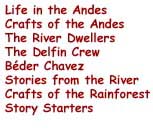

|
Friday, November 17, 2000 The Río Yanayaquillo It rained all night. As morning came, the hard rain gave way to a soft gentle rain and like most mornings, we could hear dolphins splashing and "snorting" as they swam around the Mirón Lento. Right after breakfast (have we mentioned that we eat breakfast at 6:30 AM?) we left on Mango to perform a transect of the Yanayaquillo, a tributary of the Río Samiria. The water was too low to take the Mirón Lento up the river. We quickly decided to turn off the motor so that we could count dolphins
and try to capture them with our cameras. To our amazement, there were
two tucuxi and ten botos-including a baby boto. This is the largest
group of dolphins we have seen in one spot this trip.
Vultures, Dead Fish, and Necropsy
There are two types of poison made from plants which are common to the forest. Huaca is a poison made from the ground up leaves of the plant. The stronger barbasco is made by grinding its roots into a paste. Handfuls of the prepared leaves or roots are thrown into the river.
The fish are quickly killed and can be scooped up and taken away for
immediate eating or salting. This method works well for catching fish
as nets can easily become entangled in the many fallen trees and branches
in the river.
As we reversed our route, the captain pointed out a larger fish that was in the last stages of dying. Enzo scooped it out of the water with an oar. Captain Antonio said that the blood in the eye and the bloated, red-tinged side were not consistent with the use of the poisons. We decided to quickly kill the fish so that it would not suffer and bring it back to the Mirón Lento to dissect it. Tamara and Enzo wanted to look for parasites or other obvious signs of disease. Once we were back on the Mirón Lento, Tamara preformed a necropsy. Wearing rubber gloves and being careful not to contaminate any of the boat's surfaces, she dissected the fish to try and determine the cause of the swelling. Tamara began the necropsy by scraping the armor-like scales from the
bottom of the fish. A vertical cut was made from the bottom of the mouth
to the beginning of the tail. As she examined the internal organs, there
was no sign of parasites in the fish. From all accounts, the fish looked
healthy, well fed, and had produced a sac of eggs.
When Letser and Herocio went to get more supplies from the village, they asked if anyone had seen the dead fish and if they knew what the cause might be. A man said that at this time of year the cormorants gather and feed off the fish. The birds have a virus that is transmitted to the water and the fish die. Tamara and Enzo were unable to determine why this fish was found dying or why the muscle had liquefied. They would have to examine many more fish and conduct a biopsy on the liquefied tissue in a laboratory to learn more. In the end nobody here anyway knows why the fish are dying. It demonstrates how difficult it is for scientists to find answers and how careful they must be when they make their conclusions. What appears obvious at first may not in the end be the truth. Caught on Camera
Today we saw our first caiman. It was between 2.5 and 3 meters long! We hope to see many more as we get further into the reserve. No swimming tonight. We're Taking the Weekend Off! Well, not quite. Although we will continue to conduct research and take photos over the weekend, we will not be posting daily highlights or data. Look for more updates on Monday, Nov.20. |




